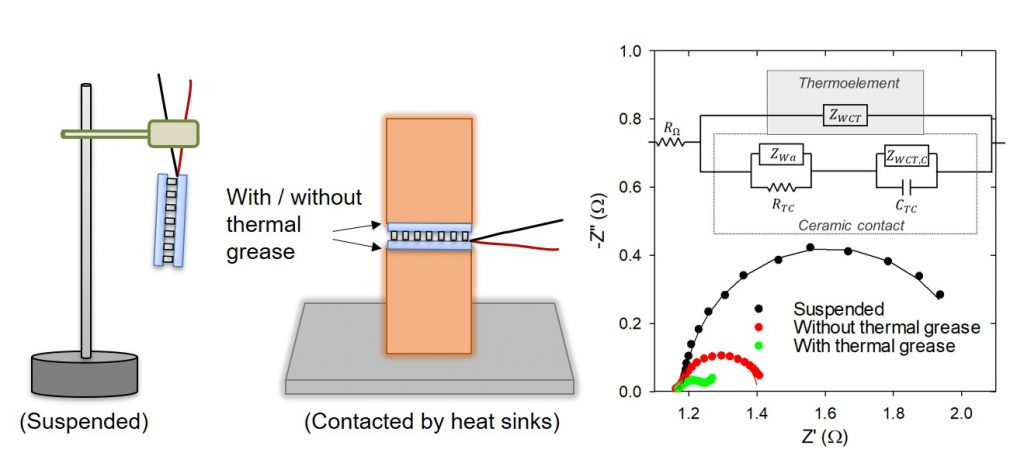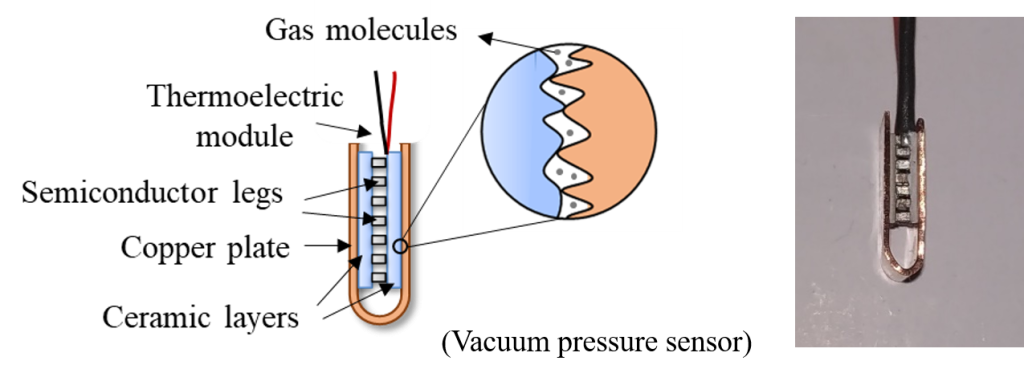Advanced characterisation methods for thermoelectric materials, devices and systems
We work on the application and development of transient and frequency-resolved methods (mainly impedance spectroscopy and current-voltage curves) to the characterisation of thermoelectric materials, devices and systems. The use of these methods allows the determination of relevant properties of thermoelectric materials, such as the electrical conductivity σ, the Seebeck coefficient S, the thermal conductivity λ, and the dimensionless figure-of-merit ZT.
In thermoelectric devices, impedance spectroscopy measurements can provide the ohmic resistance (internal resistance), the average materials properties of the thermoelements (σ, S, λ), the module dimensionless figure-of-merit, and the thermal contact resistances at the thermoelement/metallic contact and metallic contact/ceramic junctions. When thermoelectric devices are integrated into systems, impedance measurements can also provide the thermal contact resistance between the thermoelectric device and the heat exchangers.

These are some relevant publications of this research line:
- B. Beltrán-Pitarch, F. Vidan and J. García-Cañadas. Characterization of thermal contacts between heat exchangers and a thermoelectric module by impedance spectroscopy. Applied Thermal Engineering 165, 114361 (2019).
- B. Beltrán-Pitarch, J. Prado-Gonjal, A. V. Powell, F. Martínez-Julián and J. García-Cañadas. Complete characterization of thermoelectric materials by impedance spectroscopy. Journal of Physical Chemistry C 123, 12608-12613 (2019).
- B. Beltrán-Pitarch, J. Maassen, J. García-Cañadas. Comprehensive impedance spectroscopy equivalent circuit of a thermoelectric device which includes the internal thermal contact resistances. Applied Energy 299, 117287 (2021).
- B. Beltrán-Pitarch, F. Vidan, J. García-Cañadas. Thermal contact resistance evaluation of a thermoelectric system by means of three I–V curves. International Journal of Heat and Mass Transfer 173, 121247 (2021).
- B. Beltrán-Pitarch, F. Vidan, M. Carbó, J. García-Cañadas. Impedance spectroscopy analysis of thermoelectric modules under actual energy harvesting operating conditions and a small temperature difference. Applied Energy 364, 123104 (2024).
Improving thermoelectric efficiency through electrochemical strategies
We work on the development of novel TE devices that combine a nanostructured and porous thermoelectric material with an electrolyte (typically a liquid with a salt dissolved). The use of electrolytes introduce electrochemical processes that tactically modify the thermoelectric properties and significant thermoelectric performance improvements can be achieved.

Some relevant publications of this research line are:
- L. Márquez-García, B. Beltrán-Pitarch, D. Powell, G. Min and J. García-Cañadas. Large power factor improvement in a novel solid-liquid thermoelectric hybrid device. ACS Applied Energy Materials 1, 254-259 (2018).
- S. Castro-Ruiz, L. Márquez-García, M. Solis-de la Fuente, B. Beltrán-Pitarch, A. Mota-Babiloni, F. Vidan, P. Íñigo-Rabinal, G. Guisado-Barrios, J. García-Cañadas. Power factor improvement in a solid-liquid thermoelectric system formed by Sb:SnO2 in contact with a chromium complex solution. Sustainable Energy & Fuels 7, 4254 (2023).
- M. Solis-de la Fuente, S. Castro-Ruiz, L. Márquez-García, P. Rullière, S. Fantini, R. Del Olmo, N. Casado, J. García-Cañadas. Poly(diallyldimethylammonium)-based solid electrolytes to significantly enhance the power factor of a thermoelectric oxide film (Sb-doped SnO2). Sustainable Energy & Fuels 9, 1217 (2025)
Development of new applications of thermoelectric devices
From the experienced gained in our research in thermoelectrics, we have realised that a thermoelectric device is an excellent system to sense any thermal processes taking place in its surroundings. Taking advantage of this feature, we work on developing new applications where this characteristic can be exploited, such as the measurement of the thermal properties of solids an liquids, the determination of the convection heat transfer coefficient, and the measurement of the vacuum pressure.

Some relevant publications of this research line are:
- B. Beltrán-Pitarch, L. Márquez-García, G. Min, J. García-Cañadas. Measurement of thermal conductivity and thermal diffusivity using a thermoelectric module. Measurement Science and Technology, 28, 045902 (2017).
- B. Beltrán-Pitarch, J. García-Cañadas. Influence of convection at outer ceramic surfaces on the characterization of thermoelectric modules by impedance spectroscopy. Journal of Applied Physics 123, 084505 (2018).
- B. Beltrán-Pitarch, J. García-Cañadas. A novel vacuum pressure sensor using a thermoelectric device. Vacuum 172, 109088 (2020).
- V. Mendiola-Curto, B. Beltrán-Pitarch, J. García-Cañadas. Determination of thermal conductivity, thermal diffusivity, and specific heat of liquids using a thermoelectric module. Measurement Science and Technology 35, 045907 (2024).
Thermo-electrochemical devices or ionic thermoelectrics.
We work on the development of thermo-electrochemical cells (also known as thermocells or thermogalvanic cells), specially studying different electrodes and device configurations. Also, we apply the use of impedance spectroscopy to these sytems and to ionic thermoelectric capacitors.
Some relevant publications of this research line are:
- S. Castro-Ruiz, J. García-Cañadas. Evaluation of in-plane architecture in a thermo-electrochemical cell with nanostructured and porous Sb:SnO2 electrodes. Electrochemistry Communications 165, 107750 (2024).
- M. Muddasar, N. Menéndez, Á. Quero, M. A. Nasiri, A. Cantarero, J. García-Cañadas, C. M. Gómez, M. N. Collins, M. Culebras. Highly-efficient sustainable ionic thermoelectric materials using lignin-derived hydrogels. Advanced Composites and Hybrid Materials 7, 47 (2024).
- S. Castro-Ruiz, J. García-Cañadas. Evaluation of in-plane architecture in a thermo-electrochemical cell with nanostructured and porous Sb:SnO2 electrodes. Electrochemistry Communications 165, 107750 (2024).
